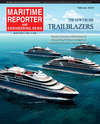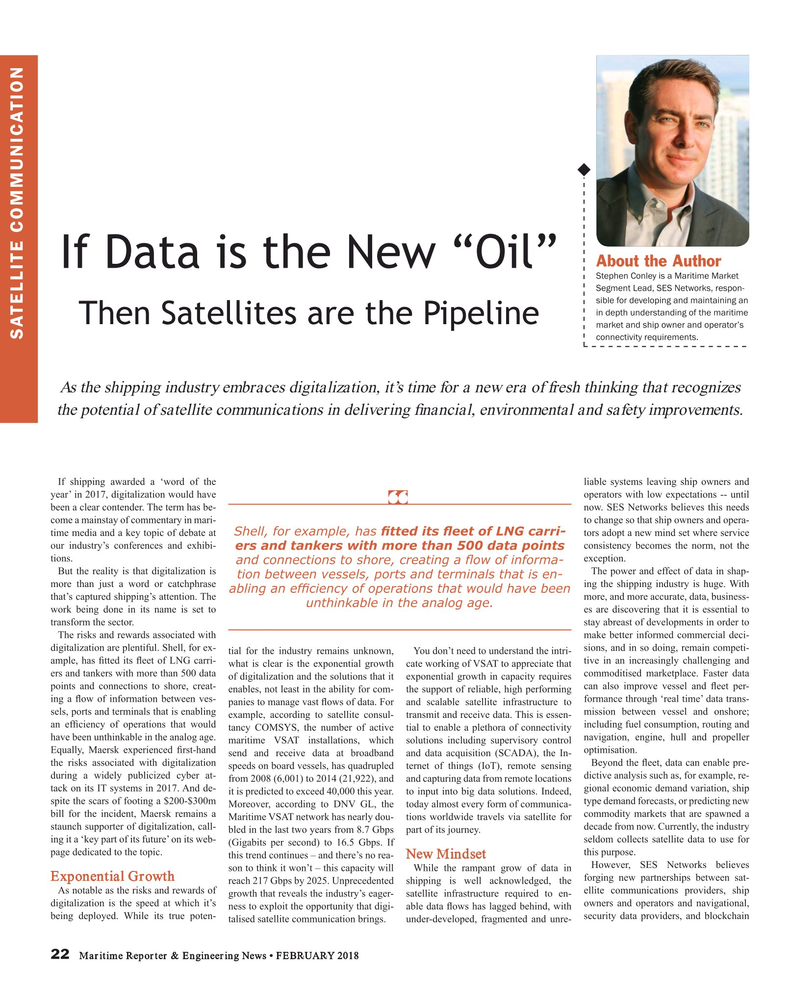
Page 22: of Maritime Reporter Magazine (February 2018)
Cruise Ship Annual
Read this page in Pdf, Flash or Html5 edition of February 2018 Maritime Reporter Magazine
About the Author
If Data is the New “Oil”
Stephen Conley is a Maritime Market
Segment Lead, SES Networks, respon- sible for developing and maintaining an in depth understanding of the maritime
Then Satellites are the Pipeline market and ship owner and operator’s
SATELLITE COMMUNICATION connectivity requirements.
As the shipping industry embraces digitalization, it’s time for a new era of fresh thinking that recognizes the potential of satellite communications in delivering ? nancial, environmental and safety improvements.
If shipping awarded a ‘word of the liable systems leaving ship owners and year’ in 2017, digitalization would have operators with low expectations -- until “ been a clear contender. The term has be- now. SES Networks believes this needs come a mainstay of commentary in mari- to change so that ship owners and opera-
Shell, for example, has ? tted its ? eet of LNG carri- time media and a key topic of debate at tors adopt a new mind set where service our industry’s conferences and exhibi- consistency becomes the norm, not the ers and tankers with more than 500 data points tions. exception. and connections to shore, creating a ? ow of informa-
But the reality is that digitalization is The power and effect of data in shap- tion between vessels, ports and terminals that is en- more than just a word or catchphrase ing the shipping industry is huge. With abling an ef? ciency of operations that would have been that’s captured shipping’s attention. The more, and more accurate, data, business- unthinkable in the analog age.
work being done in its name is set to es are discovering that it is essential to transform the sector. stay abreast of developments in order to
The risks and rewards associated with make better informed commercial deci- digitalization are plentiful. Shell, for ex- sions, and in so doing, remain competi- tial for the industry remains unknown, You don’t need to understand the intri- ample, has ? tted its ? eet of LNG carri- what is clear is the exponential growth cate working of VSAT to appreciate that tive in an increasingly challenging and ers and tankers with more than 500 data of digitalization and the solutions that it exponential growth in capacity requires commoditised marketplace. Faster data points and connections to shore, creat- the support of reliable, high performing can also improve vessel and ? eet per- enables, not least in the ability for com- ing a ? ow of information between ves- panies to manage vast ? ows of data. For and scalable satellite infrastructure to formance through ‘real time’ data trans- sels, ports and terminals that is enabling example, according to satellite consul- transmit and receive data. This is essen- mission between vessel and onshore; an ef? ciency of operations that would tancy COMSYS, the number of active tial to enable a plethora of connectivity including fuel consumption, routing and have been unthinkable in the analog age. maritime VSAT installations, which solutions including supervisory control navigation, engine, hull and propeller
Equally, Maersk experienced ? rst-hand send and receive data at broadband and data acquisition (SCADA), the In- optimisation. the risks associated with digitalization speeds on board vessels, has quadrupled ternet of things (IoT), remote sensing
Beyond the ? eet, data can enable pre- during a widely publicized cyber at- dictive analysis such as, for example, re- from 2008 (6,001) to 2014 (21,922), and and capturing data from remote locations tack on its IT systems in 2017. And de- it is predicted to exceed 40,000 this year. to input into big data solutions. Indeed, gional economic demand variation, ship spite the scars of footing a $200-$300m Moreover, according to DNV GL, the today almost every form of communica- type demand forecasts, or predicting new bill for the incident, Maersk remains a Maritime VSAT network has nearly dou- tions worldwide travels via satellite for commodity markets that are spawned a staunch supporter of digitalization, call- decade from now. Currently, the industry bled in the last two years from 8.7 Gbps part of its journey. ing it a ‘key part of its future’ on its web- seldom collects satellite data to use for (Gigabits per second) to 16.5 Gbps. If page dedicated to the topic. this purpose.
New Mindset this trend continues – and there’s no rea-
However, SES Networks believes son to think it won’t – this capacity will While the rampant grow of data in
Exponential Growth reach 217 Gbps by 2025. Unprecedented shipping is well acknowledged, the forging new partnerships between sat-
As notable as the risks and rewards of growth that reveals the industry’s eager- satellite infrastructure required to en- ellite communications providers, ship digitalization is the speed at which it’s ness to exploit the opportunity that digi- able data ? ows has lagged behind, with owners and operators and navigational, being deployed. While its true poten- security data providers, and blockchain talised satellite communication brings. under-developed, fragmented and unre- 22 Maritime Reporter & Engineering News • FEBRUARY 2018
MR #2 (18-25).indd 22 MR #2 (18-25).indd 22 2/7/2018 9:54:21 PM2/7/2018 9:54:21 PM

 21
21

 23
23
